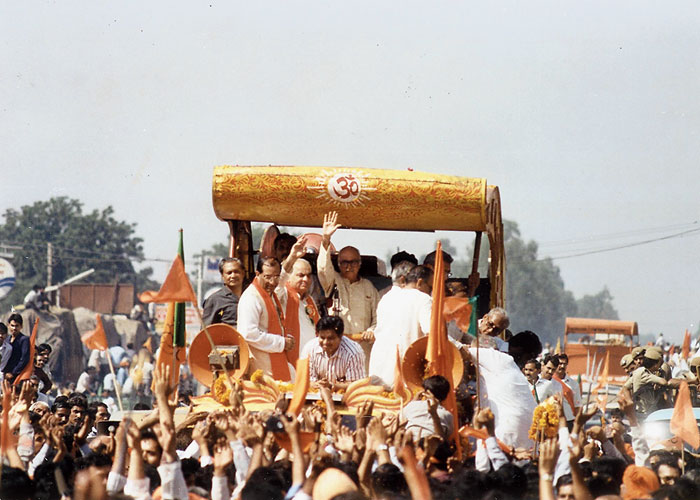On a day the Supreme Court cleared all the roadblocks in the path of a “grand Ram temple”, L.K. Advani, who had spearheaded the Ram rath yatra that led to the demolition of the Babri mosque in 1992, said he stood “vindicated” and felt “deeply blessed”.
“I stand vindicated, and feel deeply blessed, that the Supreme Court has given its unanimous verdict paving the way for the construction of a magnificent temple for Lord Ram at Ramjanmabhoomi in Ayodhya,” Advani said in a statement in the evening.
“Now that the prolonged Mandir-Masjid dispute in Ayodhya has come to an end, the time has come to leave all contention and acrimony behind and embrace communal concord and peace,” added Advani, who had earlier described December 6, 1992, the day the Babri mosque was pulled down, as the saddest day of his life.
Advani, along with Lalu Prasad Yadav and Mulayam Singh Yadav who had stood like a rock to stop the “communal forces” over two-and-a-half decades ago, now have slipped into political oblivion.
Advani, who turned 92 on Friday, remained cooped up in his Prithviraj Road bungalow on Saturday, with BJP leaders hardly recalling his contribution. On his birthday, Prime Minister Narendra Modi and some other senior BJP leaders had visited his house. On Saturday, only Uma Bharti, a prominent face of the Ramjanmabhoomi movement, paid a visit to Advani.
If this was the predicament of Advani, Lalu, 71, who had arrested him in October 1990 and halted his Ram rath yatra headed for Ayodhya, now lies incarcerated in a Ranchi hospital under judicial custody in a fodder scam case.
Former Uttar Pradesh chief minister Mulayam, 79, during whose stint in power police had opened fire on kar sevaks in Ayodhya in October 1990 to protect the mosque, appeared a pale replica of his previous avatar as a defender of minority rights.
Although Advani now has been bundled into a BJP retirement club called “margdarshak mandal”, it had been different in 1990 when he was seen as the “provocateur in chief” of communal riots across India.
Then, both Lalu, the newly elected chief minister of Bihar, and Mulayam were declared adversaries of the saffron brigade. The two had emerged as the champions of social justice, riding the Mandal wave, the proposal to implement 27 per cent reservation for OBCs.
Advani, the BJP’s mascot then, had played the “kamandal” (or religion) card to counter “Mandal” and declared to launch a Ram rath yatra from Somnath in Gujarat to Ayodhya in Uttar Pradesh to press for the construction of a Ram temple where the Babri mosque stood.
Both Lalu and Mulayam had declared that they would not allow Advani’s rath to pass through their states and foment communal trouble. It was not easy as the BJP had then extended outside support to the V.P. Singh government. It was Lalu, however, who scored over Mulayam and got Advani arrested in Samastipur.
In his autobiography From Gopalganj to Raisina, Lalu has said that he had warned Advani not to take his rath yatra through Bihar. “You must drop the yatra plan, which is aimed at fuelling riots. I have managed to restore brotherhood in Bihar after a great deal of efforts. If you don’t stop the communal march, I won’t spare you,” Lalu claims to have told Advani in Delhi before the BJP leader started his yatra.
“Let’s see which person who has had his mother’s milk can stop my chariot,” Advani, according to Lalu, had replied. “I have had the milk of my mother as well as of a buffalo…. Come to Bihar to see what I can do,” Lalu had shot back.
Lalu in the book has said that two attempts to arrest Advani in Sasaram and Dhanbad failed and then he finally succeeded in Samastipur in north Bihar.
Lalu had summoned IAS officer R.K. Singh, who is now a minister in the Modi government, and DIG-rank officer Rameshwar Oraon and got them to take Advani by surprise and arrest him in Samastipur.
The plan was kept a secret and implemented in defiance of the then home minister’s advice to allow Advani to proceed, according to Lalu. Early morning on October 23, 1990, Advani was arrested, put in a state government chopper and taken to a guesthouse in Dumka.
Advani’s arrest halted his rath yatra but fuelled protests and communal riots across several towns and cities, especially in north India. In protest, thousands of saffron kar sevaks converged in Ayodhya. Enter Mulayam.
On October 30, 1990, kar sevaks tried to storm the Babri mosque and the Mulayam administration opened fire. Around 28 kar sevaks were alleged to have been killed in two separate firing incidents. Mulayam had sought to justify the firing, saying the “unity and integrity” of India had to be safeguarded.
The BJP withdrew support to the government after Advani’s arrest. The V.P. Singh government, however, claimed that the withdrawal was because of the decision to implement the Mandal Commission report suggesting 27 per cent reservation to OBCs.
On December 6, 1992, the Babri mosque was demolished in the presence of Advani and other senior BJP leaders. By then, Mulayam had lost power and the BJP’s Kalyan Singh was chief minister.











